Guest Post by Eric Peters
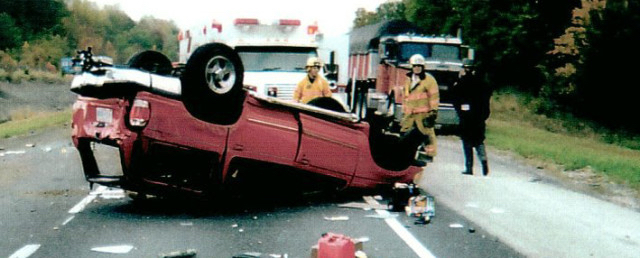
When does cancer start?
At the cellular/molecular level, probably. Which makes discovering the moment of conception – so to speak – difficult to pin down.
Political cancer is easier because we can see it and sometimes even touch it, at the critical moment when it could have been given a bleach bath or something else hygienically suitable.
One such moment occurred in the early spring of 2000 – when the National Highway Traffic Safety Administration – an apparat of the busybodies and control freaks who constitute “the government” – began what would turn into a Mueller-like witch hunt focused on the supposed defects of Ford’s Explorer SUV and the Firestone tires it came shoed with from the factory.
The real defect lay with the drivers – who drove too fast on tires not meant for high-speeds and often without enough air in them, resulting in heat build-up and failure of the tires at high speeds.
But the blame for this lay with the busybodies and control freaks who set it all in motion.
Herewith some history:
The Explorer – one of the very first “SUVs,” as they are commonly styled today – was basically a pick-up truck with its bed enclosed and carpeted. Such vehicles weren’t new in 1990 – when the Explorer made its debut.
But they were becoming common.
Previously, they were not.
Chiefly, because those pre-SUVs (models like the original Ford Bronco, the Chevy K5 Blazer, the International Scout, etc.) weren’t suitable for daily transportation. They were trucks with enclosed beds, remember. And the trucks they were based on were – in those days – not far removed from farm implements.
They were made for work (and recreation) more than transportation.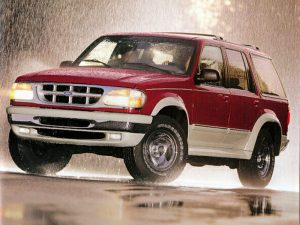
Enclosing the bed didn’t change the design – but the marketing changed very much. The Sport Utility Vehicle was born, or rather named.
These “SUVs” – as they were branded – were designed to drive through the “loophole” (as anything which makes it legally feasible to evade a government fatwa is styled) which existed in the fine print of the federal fuel efficiency fatwas which applied a lower mandatory minimum average MPG number to what were then-styled “light trucks” – which basically meant half-ton (and smaller) pick-ups. Which in those days were – as noted above – used mostly for work and recreation and made in relatively small numbers.
Uncle – in a moment of backhanded generosity – didn’t initially apply the full force of the fuel economy fatwa’s terms to them, because doing so would have made it very hard for the car companies to continue building them without fundamentally redesigning them.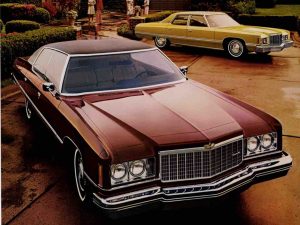
But “passenger cars” were redesigned.
Over the course of about a decade – from the imposition of the federal fuel economy fatwa in the mid-1970s to about the mid-1980s, when it really began to bite – the typical American passenger car transitioned from full-sized and rear-wheel-drive to compact-sized and front-wheel-drive.
The Chrysler K-car became the archetypical mass-market American car.
But Americans, damn their eyes, still pined for the big cars which the fatwas had made too costly to manufacturer except as low-volume/high-priced luxury cars. And then an epiphany. Someone remembered the “loophole” in the fatwas for “light trucks” and realized that a “light truck” with an enclosed bed could drive through the “loophole” just as well as a pick-up with an open bed.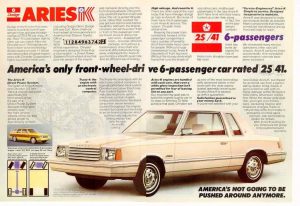
And pick-ups were still big. And more powerful than the gelded four cylinder FWD “shitboxes” (in the immortal words of Brock Yates) that the fatwas had foisted on the American public.
Plus, they were capable. Trucks have 4WD and are good in the snow and for pulling trailers. A truck with an enclosed bed could be just as good – and carry more people than a truck. Add nice carpet. Amenities.
Voila – the SUV was born.
And, marketed – as the new car. As the versatile and do-anything (and some things better) than a mere car.
The ocean swelled; a tsunami formed.
SUVs became mass-market, everyday-driven “loopholes” to government busybodyism.
Then came the rub.
Many – probably most – of the people who bought their first SUV back in the mid-late ‘80s and into the early ‘90s had never driven a truck before. And were encouraged not to think of their SUV as a truck with an enclosed bed. Instead, they were encouraged to consider it a car.
And drive it accordingly.
Enter disaster, the progeny of unintended consequences born of government busybodyism and control freakishness.
The first-generation SUVs were very much trucks under their skins – and not designed for high-speed driving, much less high-speed maneuvering. The farmers, outdoorsmen and others who had been the primary buyers of trucks heretofore knew all this and drove accordingly. That is to say, slowly. And carefully. But the average Americans who bought “SUVs” often did not – and in large numbers.
Inevitably, there were spectacular wrecks.
These tend to occur when a truck with an enclosed bed is driven at 70, 80 even 90 MPH for long stretches on hot days and on tires not designed for sustained high-speed driving, as the Firestone tires in question were not.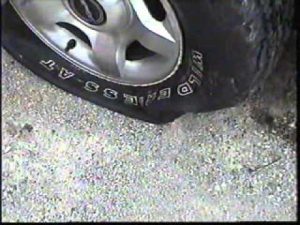
These tires were also often run fast and hard while low on air – accelerating the build-up of heat and increasing the stress on the tire until it finally failed, catastrophically.
A sudden blowout rather than a slow leak.
While running 70, 80 or 90 MPH in truck with an enclosed bed.
A vehicle jacked up for off-road driving – riding on a suspension made for low-speed slogging.
When a tire failed violently and suddenly, the weight of the vehicle also shifted suddenly. The instinctive reaction of the driver was an over-reaction, too much steering or braking input. The truck with an enclosed bed swerved, sometimes out of control . Because of the truck with an enclosed bed’s high center of gravity, a roll became likely at this point.
A number of Explorers – several hundred of them – did exactly that. About 271 people were killed in these rollover wrecks. Which actually isn’t that many, considering how many Explorers (and Firestone tires) were made – which was several million.
It’s actually testimony to the general soundness of the Explorer – and Firestones’ tires – that so few people were killed. Most Explorer drivers never had trouble, despite driving their SUV beyond the built-in limitations of its design.
But rather than explain to the people buying these vehicles that trucks with enclosed beds ought not to be driven as if they were cars but with respect for their truck-descended designed-in limitations or (better yet) rescinding the federal fuel economy fatwa that distorted the market and created the problem in the first place, Ford and Firestone were put into the Thunderdome – two men enter, one man leaves – and left to slog it out.
The debacle cost Ford more than $5 billion and practically ruined Firestone.
It also cost all of us.
The solution to this government-created problem was a new fatwa that all vehicles – not just SUVs – be fitted with a tire pressure monitoring system (TPMS).
These were not installed for free.
In addition, they sometimes don’t work.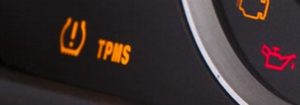
The warning light in the dashboard comes on but a check of the pressure manually shows all to spec. People thus ignore the warning, on the boy-who-cried wolf principle. Or they assume the tire pressure is within spec because the light does not come on. But the system may not have noticed the pressure is out of spec.
It might be sounder policy to encourage people to actually check the air pressure every so often; you know – see for themselves – rather than remain in a state of torpid quiescence because a light has (or has not) illuminated.
Back to etiology – the science of disease progression.
Ford and Firestone should have stood their ground and pointed out all the points you’ve just read about.
That the federal fuel economy fatwa created the “SUV” as a mass-market response to unnaturally downsized cars; that “SUVs” would probably have never come into existence absent the fatwa and so remained low-volume niche vehicles for people who understood what they were for (and not for) and drove them appropriately. (Note the fact that there was no Rollover Crisis before “SUVs” became mass-marketed as alternatives to downsized cars. This was because the people who bought “SUVs” before they were called “SUVs” drove them with respect for their limitations.)
Ford and Firestone should have explained that driving a truck with an enclosed bed at 70, 80 or 90 MPH on a 100 degree day for hours at a time on underinflated tires not designed for high-speed driving even when properly inflated is probably not a very good idea.
They both could have spent a fraction of the billions it eventually cost them on a marketing blitz to educate people that this bad idea – the “SUV” – was the unintended result of busybodies and control freaks – aka, “the government” – dictating to people (via fatwa) how much gasoline their cars will be allowed to use.
Instead, more of the same – and tire pressure monitors for all.
Plus a whole lot more.
It is my sincere desire to provide readers of this site with the best unbiased information available, and a forum where it can be discussed openly, as our Founders intended. But it is not easy nor inexpensive to do so, especially when those who wish to prevent us from making the truth known, attack us without mercy on all fronts on a daily basis. So each time you visit the site, I would ask that you consider the value that you receive and have received from The Burning Platform and the community of which you are a vital part. I can't do it all alone, and I need your help and support to keep it alive. Please consider contributing an amount commensurate to the value that you receive from this site and community, or even by becoming a sustaining supporter through periodic contributions. [Burning Platform LLC - PO Box 1520 Kulpsville, PA 19443] or Paypal
-----------------------------------------------------
To donate via Stripe, click here.
-----------------------------------------------------
Use promo code ILMF2, and save up to 66% on all MyPillow purchases. (The Burning Platform benefits when you use this promo code.)






Generally true, however Ford and Firestone both bear some culpability.
Ford demanded lower cost tires which Firestone provided by removing a liner from the tire carcass. Ford also wanted lower pressure to improve ride quality. Firestone agreed to the lower pressures listed on the vin tag. Thus 42 psi- capable tires were only inflated to 28 psi.
There also have been many documented cases where the anti-sway bars of the Explorer suspension came loose and stopped working due to corrosion of their mounts. When this happens the vehicle acts like it has a softer suspension and will roll (body roll, not flip over) and sway much more easily. That, in turn, can lead to driver responses that increase the likelihood of total loss of control and a rollover.
“Did I hear that wrong Barney or are they talkin’ about us?”

Don’t buy it. Article is entirely off the cuff. I had a Ford pickup – worst engineered piece of oral I ever owned. Who does the writer work for?
You obviously don’t like Ford trucks. Most people don’t like certain brands. For example, I don’t think very highly of Toyotas, Nissans, and Subarus. So what do you drive?
Meyer?
I’m sure you’ll fit right in here.
I wouldn’t mind if Someone was able to make cars and trucks from the early 1990’s again. Many had decent steel, unlike today’s vehicles which often are rusting out after 6 years due to the Chinese steel they make them out of. There was no active fuel management, which often translates to $7000+ repairs about the time it has 100,000 miles on it. There were no 10 speed automatic transmissions, which can cost about $10000+ to repair. You can still get parts for vehicles of that era, unlike the ones of today where it can be a nightmare to find electronic parts for a 6 year old vehicle. Yes, many early ’90’s vehicles still used throttle body fuel injectors, which are easy and cheap to service unlike the new cars whose multiport fuel injector systems results in $2000+ repairs. Yeah, you could keep those vehicles for ever and the expected repair costs were very economically feasible, unlike the shitboxes made today.
There was also a problem with the geometry of the rear suspension which Ford corrected when they went to an independent rear suspension. A flat tire should not cause a vehicle to change direction and roll as long as the wheels are tracking straight.